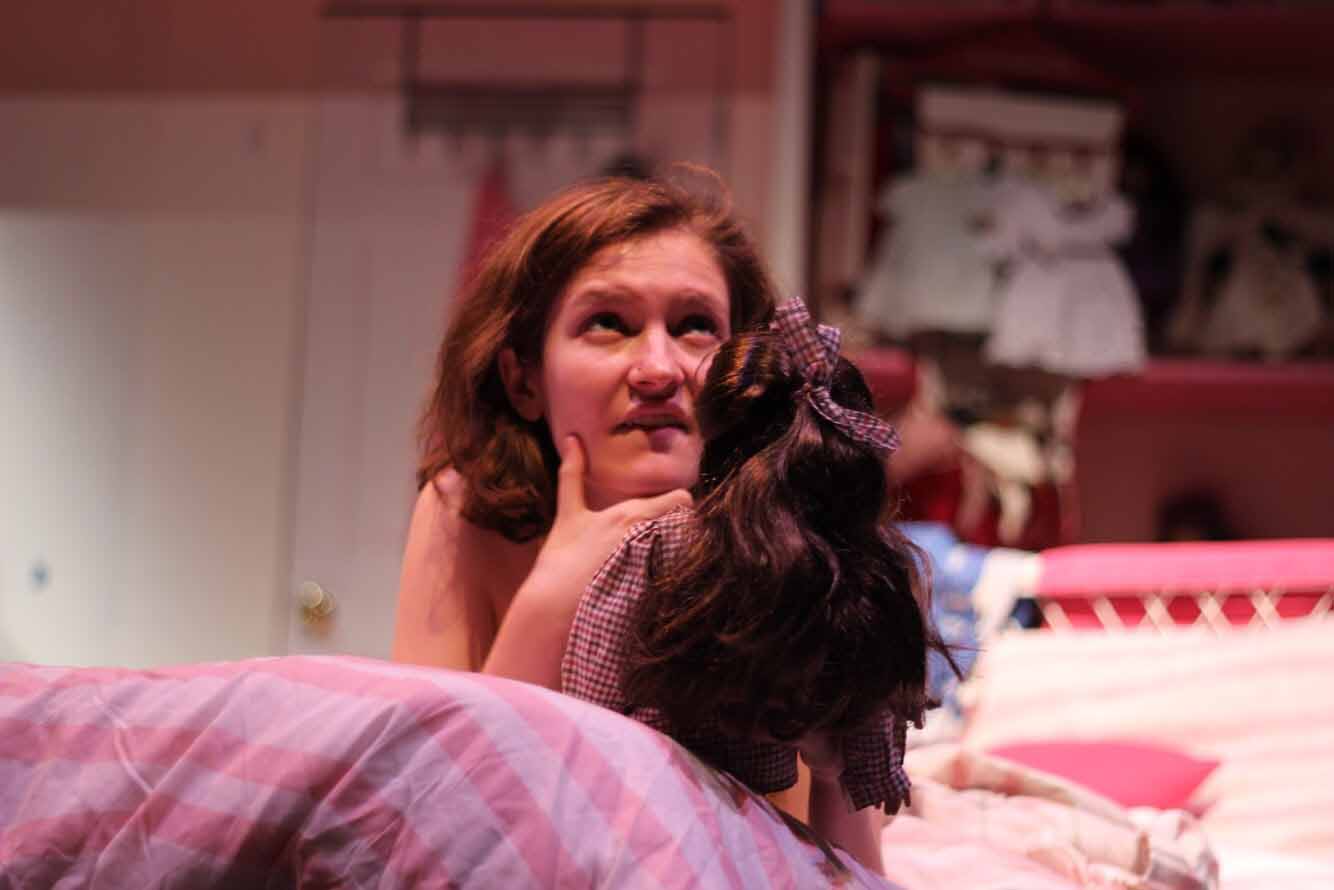
Ryan Seffinger
The set strikes you at once. Blush-colored carpet, shaggy magenta rug, pink shelves lined with American Girl dolls, shoes and clothes. Haphazard shirts and a stray bra sprawl across the bedroom floor. Such is the setting for the Yale University Dramatic Association’s production of “Girlish,” written by Alexa Derman ’19, produced by Gillian Fu ’20, directed by Jacqueline Blaska ’20. Exploring themes of sexuality, queerness and the transition to womanhood, the play follows the effects of these themes on the relationship between best friends Windy (Walker Caplan ’20) and Marti (Agnes Enkhtamir ’19). Despite the bizarre and unfulfilling ending, Girlish is a delightful play that presents a convincing and relatable picture of distinctly feminine youthfulness through funny quips, great acting and thought-provoking ideas.
Although she is an Instagram-famous American Girl doll blogger, Windy is still in the cringe-y phase of adolescence, where she can never find the right words and very clearly feels uncomfortable in her own skin. Marti, in contrast, seems very much in touch with herself, setting off an immediate tension between the two friends at the start of the play. This tension is heightened by the introduction of AGBOI97 (Branson Rideaux ’20) — an older college boy and fellow American Girl doll Instagrammer — and Marti’s increasingly complicated feelings toward Windy.
Caplan plays an incredibly convincing adolescent, awkward and fumbling through her burgeoning sexuality. Yet, I found myself most drawn to Enkhtamir’s portrayal of Marti, particularly towards the end of the play. Marti’s transition from Windy’s suave mentor, perpetually more knowledgeable on topics related to sexuality, to a fiercely confused and emotionally disheveled teenager was my favorite part of the play.
As a character, AGBOI97 felt very one-dimensional, which was surprising given his role as the main love interest in a three-person play. I think this was an intentional choice on Derman’s part, as it kept audiences focused on the two girls and their respective sexual awakenings. This decision to make the girls the play’s focal point would help to explain AGBOI97’s lack of presence in the climax and denouement of the play. Additionally, it is interesting to note that, while Rideaux is present on stage, AGBOI97 as a character is never physically present, instead interacting with Windy through texts. This, too, could account for AGBOI97’s bland characterization, as he would have the additional digital barrier to filter his personality.
Technology plays an interesting role in Girlish. I absolutely loved how, whenever Windy made a video about her dolls, the video was enlarged and projected in real time onto the pink shelves behind her, giving the audience the perspective of one of Windy’s followers as well as an invisible observer of her video production process. At times, though, the ever-present technology felt insidious. It is through Instagram that Windy lives much of her life. Often during scene transitions, you can see the glow of Windy’s phone. She is constantly posting videos and photo shoots of her dolls, which is how Windy first connects with AGBOI97. Furthermore, the distance created by communication through technology masks the uncomfortable age gap between 15-year-old Windy and 19-year-old AGBOI97. While watching the play, I thought this was a fascinating dynamic, particularly in light of the ever-present role of technology in our lives and its role in fundamentally reshaping relationships and human interactions.
There was also a decidedly voyeuristic aspect to the play. The transition from girlhood to womanhood is a deeply personal and intimate transformation, and it felt intrusive to be privy to this aspect of Windy and Marti’s lives. In addition, the very setting of Windy’s bedroom lent itself to uncomfortable moments, namely watching her changing clothes, at first in the dark, then later with the lights on. This, though, I think is meant to provoke discomfort, to thrust this aspect of girlhood — Windy’s increasing comfort with her own body and sexuality — in your face. Even with the nudity, rather than feeling salacious, the play still felt much more like an innocent exploration of sexuality.
I must say, the ending was utterly confusing to me. Marti walks into the moonlit bedroom dressed in a posh white dress and sun hat, clearly emulating an American Girl doll. At the forefront of the stage sits Samantha, Windy’s look-alike doll. As Marti enters the room, she calls out to Samantha, “I have so much to tell you! Where are you?” I understand that each American Girl doll is representative of girls universally, a point hammered home throughout the play, expanding the niche focus of the play to a broader message about the cringe-worthy transition between girlhood and womanhood. This expansion of focus is made all the more interesting by Derman’s transformation of an innocent symbol of girlhood to one of awakening sexuality.
But still, I found it difficult to understand the scene itself. Why did the play end with Marti? Was there some significance in the play ending at night? How did this scene relate to the one just before? It also felt bizarre that the catalyst for so much tension in the play was completely absent from not only the climactic fight scene between Marti and Windy, but also the ending. While “Girlish,” a play essentially about the everyday girl and the beginnings of her transition into womanhood, does not seem to be the kind of play to have a dramatic ending, the resolution (or rather, the lack thereof) felt a little too anticlimactic and abrupt for my liking.
Overall, though, “Girlish” was a pleasure to watch — both for its stellar acting and the thought-provoking ideas it raised. I think it’s safe to say that theatergoers will never look at American Girl dolls in the same way again.
Selena Lee | selena.lee@yale.edu .







